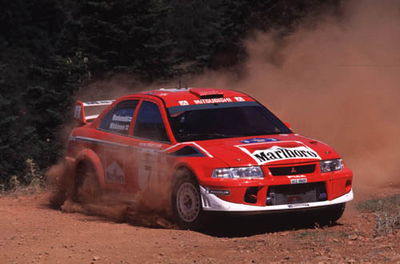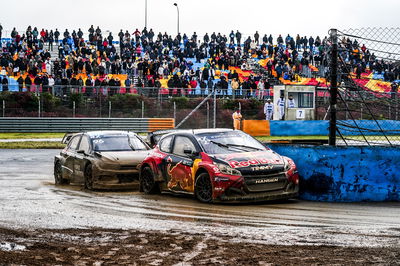Makinen: The car is the best I've ever had.
The Marlboro Mitsubishi Ralliart crew of Tommi Makinen and Risto Mannisenmaki lead the Safari Rally at the end of the opening leg and 351 competitive kilometres.

The Marlboro Mitsubishi Ralliart crew of Tommi Makinen and Risto Mannisenmaki lead the Safari Rally at the end of the opening leg and 351 competitive kilometres.
The Finns, who have been in spectacular form in their Lancer Evolution, have over one and a half minutes in hand to second-placed Carlos Sainz going into Saturday's longest and toughest leg. Team-mates Freddy Loix and Sven Smeets were running well earlier and set equal fastest time in CS2. They hit problems later this afternoon, but nevertheless hold eighth position.
Thousands of spectators lined the streets of Nairobi early this morning as the 41 competing crews left the capital city for today's four competitive sections. With the event moving to July for the first time in its history, conditions are a stark contrast to previous years with blanket cloud cover, temperatures around 20 degrees Centigrade and rain.
Today's route took the contenders to the south of the city and, while overnight rain may have eased any dust problems, the roads have still been treacherously rocky and littered with deep ruts that pose a constant threat to mechanical components. In fact, no fewer than five of the leading drivers have retired.
Richard Burns failed to get beyond section one when he damaged the Subaru's suspension and Colin McRae retired with clutch failure after earlier steering problems and an excursion off the road. Didier Auriol went out late this afternoon when he rolled and the car caught fire, his Peugeot team-mate Marcus Gronholm retired when he lost a wheel and Toshi Arai joined them with unconfirmed broken front suspension on the Subaru.
Tommi Makinen and Risto Mannisenmaki have, in contrast, had a mechanically trouble-free run and in fact the Finnish four-times World Champion could not be more delighted with his Lancer Evolution and Michelin package here in Kenya.
"The car is the best I have ever had, it's fantastic and so easy to drive!" he enthused. "The tyres are a dream and I'm really enjoying myself."
Makinen, who has set one equal fastest and three second fastest times today, has however encountered the Kenyan wildlife and was visibly shaken when he arrived at the Whistling Thorns service park after the first competitive section.
"A bird flew straight into the windscreen on my side of the car and made a hole in the glass. It was not so nice at all," he said. "We then had dust and glass flying in through the hole. It then happened again later in the day, but fortunately didn't hole the windscreen that time. The only small problem we have had was in section four when the tyre pressure went up and we couldn't go flat out, but other than that I'm very happy."
Team-mates Freddy Loix and Sven Smeets have limited experience of the Safari but have been pacing themselves perfectly and set equal fastest time with Makinen on section two. The Belgians are undoubtedly benefiting from the experience of former Safari Rally winner Ian Duncan - who is making their gravel notes on this event - but both Loix and Smeets have had their own share of problems.
"Five or six kilometres into section three we cut a corner and hit a big stone that was not marked in our notes," said Loix. "We got a puncture, stopped and changed it, but after less than a kilometre we had to stop again because the suspension arm had broken. Then in section four we broke a drive-shaft going through a watersplash. It was raining really hard, the windscreen was all steamed up and then the car just started to slow down. Because of the broken drive-shaft, the wheel sensors were not working and this gave the wrong information to the ignition. I had to drive the rest of the section with my finger holding down the ECU button before we could make repairs at the end."
The second leg of the Safari Rally takes the contenders 200 kilometres north of Nairobi and across the equator for five competitive sections and a daunting 426.24 competitive kilometres.










